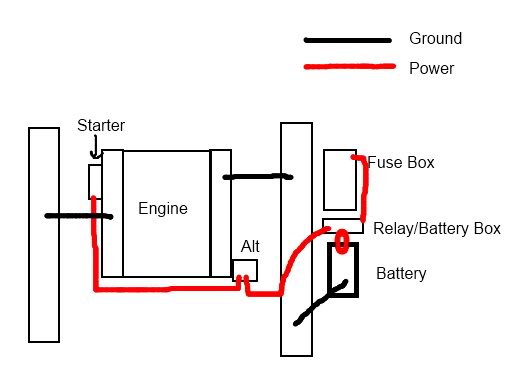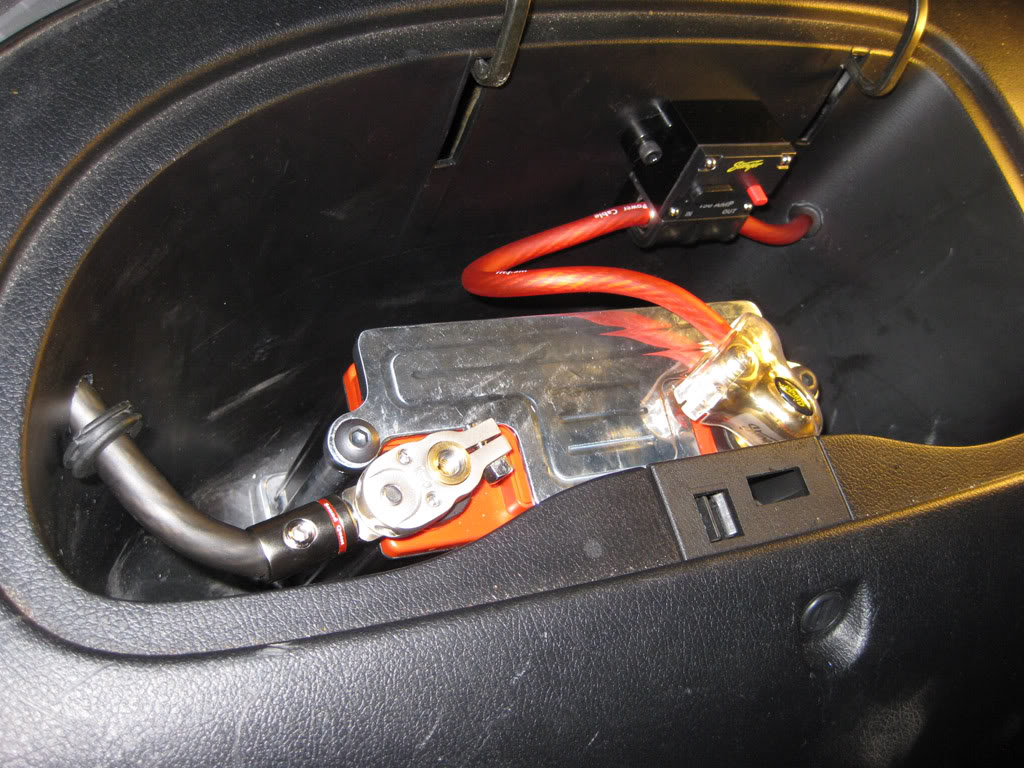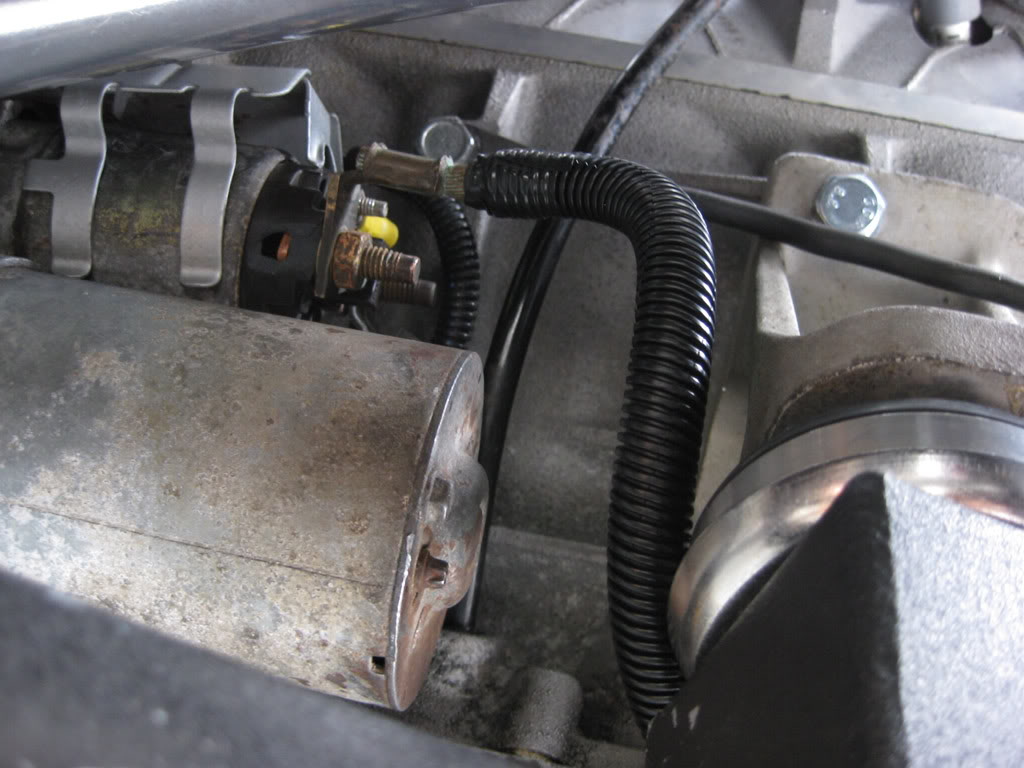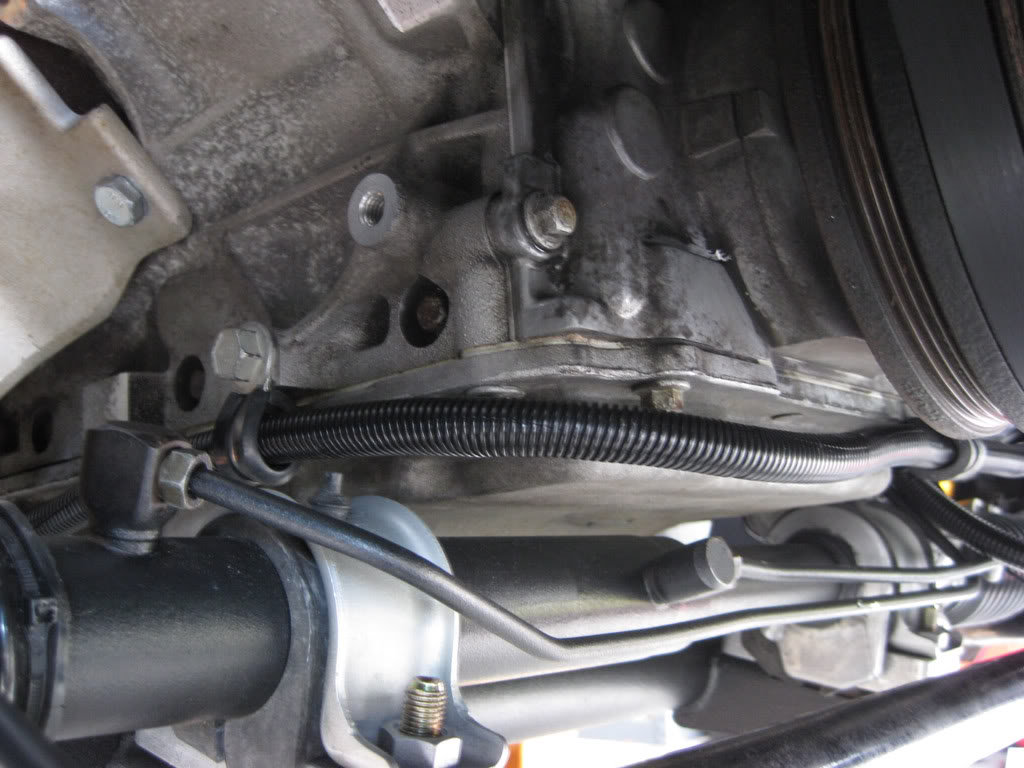Battery relocation issues
#1
Battery relocation issues
So had a battery relocation done. And now the car will not turn over on battery alone. We tried a million ways to troubleshoot the problem but are still not entirety sure what it is.
The set up is this:
4 gauge cable from the fuse block, to the passenger compartment. 150amp circuit breaker. 4 gauge ground from the compartment to a bolt on the body(interior).
Using the stock chassis ground that runs from the bay to the chassis under the alternator, and the alternator is run directly to the fuseblock as well.
New cable is the one in the nylon loom to the right. You can see the ground strap circled in red.
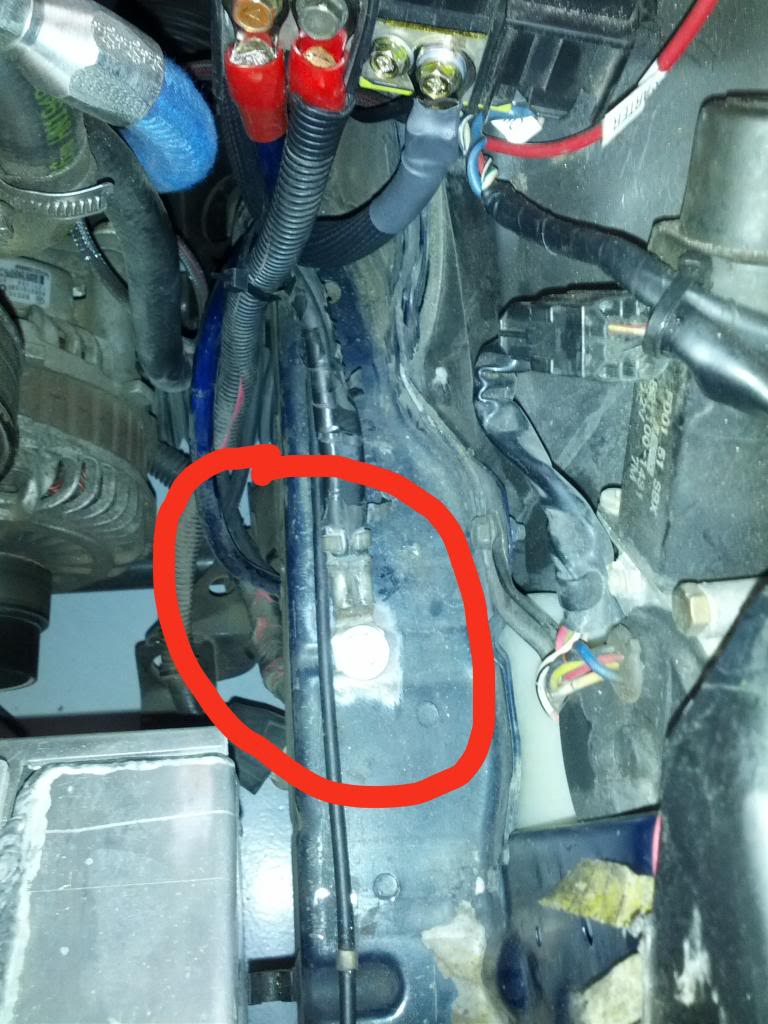
We are seeing a voltage drop of roughly 6v from the battery to the fuse block. No additional wiring is ran to the starter or alternator. Both are just running off the existing wiring.
Is 4 gauge wire not good enough? Do we need more grounds? After trouble shooting it seems more like a power issue, but
Any help would be greatly appreciated.
The set up is this:
4 gauge cable from the fuse block, to the passenger compartment. 150amp circuit breaker. 4 gauge ground from the compartment to a bolt on the body(interior).
Using the stock chassis ground that runs from the bay to the chassis under the alternator, and the alternator is run directly to the fuseblock as well.
New cable is the one in the nylon loom to the right. You can see the ground strap circled in red.

We are seeing a voltage drop of roughly 6v from the battery to the fuse block. No additional wiring is ran to the starter or alternator. Both are just running off the existing wiring.
Is 4 gauge wire not good enough? Do we need more grounds? After trouble shooting it seems more like a power issue, but
Any help would be greatly appreciated.
#2
You're problem, voltages drop @ 6V that's literally half of what's battery voltage...
I personally use 0 gauge. But the bare minimum people uses were 2 gauge. I think 4 gauge is just not sufficient.
-AzEKnightz
I personally use 0 gauge. But the bare minimum people uses were 2 gauge. I think 4 gauge is just not sufficient.
-AzEKnightz
#3
I had issues with slow cranking when I had 4 gauge wire, switch to O gauge and also went directly to starter instead of the front and problem solved.
For the ground I ran a 36" 4 gauge wire from passenger side bin to the rear passenger side shock tower.
For the ground I ran a 36" 4 gauge wire from passenger side bin to the rear passenger side shock tower.
#4
Ok so it seems like that is the problem huh?
How does this sound for a solution.
1. Since I already have the 4awg going to the bay, attaching that to the rear ground next to the battery, and grounding it to the engine up front.
2. Then just running a new 0-2awg for the power direct to the starter.
One question on "1" would be should I then jump a ground from the engine back to the chassis, or would that be sufficient?
How does this sound for a solution.
1. Since I already have the 4awg going to the bay, attaching that to the rear ground next to the battery, and grounding it to the engine up front.
2. Then just running a new 0-2awg for the power direct to the starter.
One question on "1" would be should I then jump a ground from the engine back to the chassis, or would that be sufficient?
#7
I used 4 gauge before with no issue on a optima battery and a bike battery. Make sure your teminals are crimpped correctly and tight. You battery terminals are tight and you have a good ground. I make sure I put on on bare metal then I would put silicone on it to prevent it from rusting.
Trending Topics
#8
My setup was identical to yours except one thing, I used a 0 gauge for the ground to the body. I use 4 gauge power with no issues. I do recommend a stand alone wire from the battery positive directly to the starter. I changed that in my recent rewire. Then run another 4 gauge to the engine bay fuse block and have the alternator cable join that there.
The starter really needs its own lead to the battery, and you need a solid ground. Try adding another ground from the negative terminal directly to the transmission, or on the bottom side of the hole you originally drilled for the negative, link it to the transmission that way.
Amps are only as good as the ground you provide.
The starter really needs its own lead to the battery, and you need a solid ground. Try adding another ground from the negative terminal directly to the transmission, or on the bottom side of the hole you originally drilled for the negative, link it to the transmission that way.
Amps are only as good as the ground you provide.
#9
Remember one thing, use the same gauge wire for both power and ground.
DO not use a 0-2 gauge wire for power, then ground @ 4 or less. It WILL creative a massive resistance.
-AzEKnightz
DO not use a 0-2 gauge wire for power, then ground @ 4 or less. It WILL creative a massive resistance.
-AzEKnightz
#10
I used 2 gauge all around and works great, battery in the hatch with a power wire right to the starter, I also upgraded all but 2 grounds to 8 gauge (battery has 2 gauge) and added a few, a lot of minor issues went away
#11
I think the main issue is just not going to the starter first. I think before I do anything the logical step is trying the 4 gauge to the starter, and add one extra ground on the passenger side from the block to the chassis.
If that works I am going to redo a few other grounds, and redo the wires from the alternator to the fuse box.
#12
You need to run a continuous ground from the battery, chassis, and engine (like pretty much all factory vehicles do). My rear bin battery's ground goes to the lower seat chassis anker, then it goes up the center towards the shifter housing and bolts to the rear of the transmission. You always wanna keep your grounds as short as possible. My positive cable goes directly to the fuse panel. I use 2 gauge for both wires and a little Miata battery that starts my 20b.
#13
you need to run a continuous ground from the battery, chassis, and engine (like pretty much all factory vehicles do). My rear bin battery's ground goes to the lower seat chassis anker, then it goes up the center towards the shifter housing and bolts to the rear of the transmission. You always wanna keep your grounds as short as possible. My positive cable goes directly to the fuse panel. I use 2 gauge for both wires and a little miata battery that starts my 20b.
#16
Cool, I am going to run a 2 ga ground tomorrow from the chassis grounded negative to the trans. Is there anything special I am looking for in the bolt/nut to maximize the ground? I will need to run to the hardware store or autoparts store and buy something.
#17
You need to see where the high resistance is causing the voltage drop, for example see if its not a 6 volt drop at the engine bay but a voltage drop at the circuit breaker or distribution block. Check the resistance of your power wire it shouldn't be over half an ohm.
4 gauge isn't your problem that would be a problem when you try to pull amperage through it, your checking for voltage right now.
4 gauge isn't your problem that would be a problem when you try to pull amperage through it, your checking for voltage right now.
#18
You need to see where the high resistance is causing the voltage drop, for example see if its not a 6 volt drop at the engine bay but a voltage drop at the circuit breaker or distribution block. Check the resistance of your power wire it shouldn't be over half an ohm.
4 gauge isn't your problem that would be a problem when you try to pull amperage through it, your checking for voltage right now.
4 gauge isn't your problem that would be a problem when you try to pull amperage through it, your checking for voltage right now.
Resistance was only .2ohm at the front fuse block.
I think it just comes down to needing the power to the starter directly. But either way I am going to ground the trans like everyone is suggesting. The more the merrier.

This is on a v8 swap with pc680 battery so I am sure it is demanding.
#19
I believe he measured voltage drop when cranking.
Resistance was only .2ohm at the front fuse block.
I think it just comes down to needing the power to the starter directly. But either way I am going to ground the trans like everyone is suggesting. The more the merrier.
This is on a v8 swap with pc680 battery so I am sure it is demanding.
Resistance was only .2ohm at the front fuse block.
I think it just comes down to needing the power to the starter directly. But either way I am going to ground the trans like everyone is suggesting. The more the merrier.

This is on a v8 swap with pc680 battery so I am sure it is demanding.
Make sure you are charging the pc680 with the proper charger too, good luck.
-Chance
#20
I see, I misunderstood. It shouldn't go below 9v while cranking. I also have a pc680 with a ls3, I had 4 gauge and it worked fine but I would have hot start issues. I now have 0 gauge and it helped but its not perfect. The battery is too small for our engines IMO, I will be changing it soon.
Make sure you are charging the pc680 with the proper charger too, good luck.
-Chance
Make sure you are charging the pc680 with the proper charger too, good luck.
-Chance
Think I'm going to grab one of the ACI chargers made for the oddesey.
Thing is before the relocation it slow cranked but never was an issue. I should have just left it upfront but did the fuel pump wiring and figured it was a good time to do the relocation.
#21
Yes, I originally ran it from the passenger bin to the starter down the back of the head but it was too close to the header. So, I decided to reroute it and had some 0 gauge, I routed it along the fuel rail and down to the starter to avoid the header(heat=resistance).
I have the power wire routed from the battery to the starter and then jumps to the alternator and up to the oem fuse box.
I have the power wire routed from the battery to the starter and then jumps to the alternator and up to the oem fuse box.
#22
You need to run a continuous ground from the battery, chassis, and engine (like pretty much all factory vehicles do). My rear bin battery's ground goes to the lower seat chassis anker, then it goes up the center towards the shifter housing and bolts to the rear of the transmission. You always wanna keep your grounds as short as possible. My positive cable goes directly to the fuse panel. I use 2 gauge for both wires and a little Miata battery that starts my 20b.
#23
Whatever you run, both cables need to be the same gauge as current goes in a complete circle (+ to the device and back to ground). Different sizes and cable lengths create resistance and voltage drop. I'm getting ready to slightly modify the set-up and take my hot wire to the starter 1st then to the fuse panel. This creates less voltage drop from the battery to the starter (and what I should have done in the 1st place). I'm also gonna upgrade my battery to a Braile B3121 as it has way more reserve capacity than the Miata battery. Lastly save your self some money and go to a local Airgas or welding supply shop and buy their HI strand 2 gauge grounding cable for the welding machines. Should only be 2-3$ a foot. I use this cable for both wires as having a dedicated red wire isn't neccessary. Just wrap some red tap on the ends for I.D. purposes.
#24
I may as well add some upgraded alternator info. Any time you upgrade the alternator amps, you also need to upgrade the charge cable and also install a secondary fuse near the main 100 amp fuse. Reason is the factory 100 amp alternator is matched to 100 amp fuse. If you install (say) a160amp alternator, you need to add 60 more amps of current flow capability to the fuse panel by adding a 60 amp fuse in that blank spare location next to the original 100 amp fuse and a larger charge wire capable of carrying 160 amps. If you don't do this, you will never get the full benefits of the higher amp alternator as you simply can't move 160 amps of current through the small factory charge wire an 100 amp fuse. This gets over locked quite oftern around here.
#25
Ok so here is my question. I went out to try and make heads or tails of what is currently there.
This is what I found. There is a blue wire and the one with the plastic loom both coming out of the fuse block.
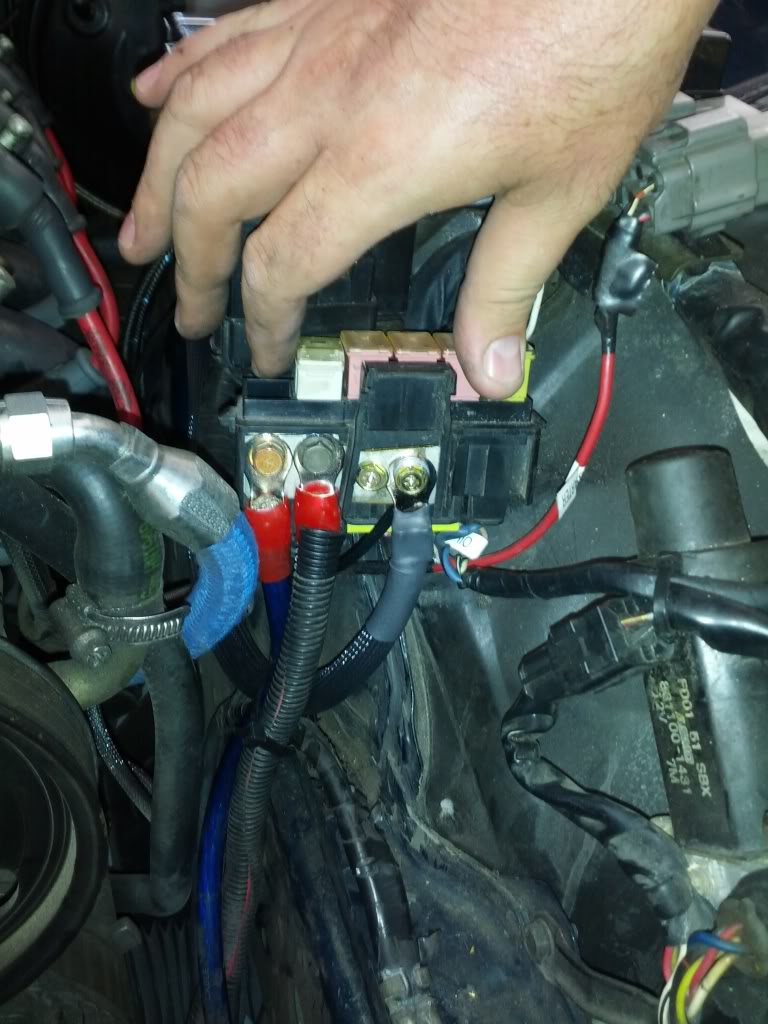
They run down directly under the engine bay
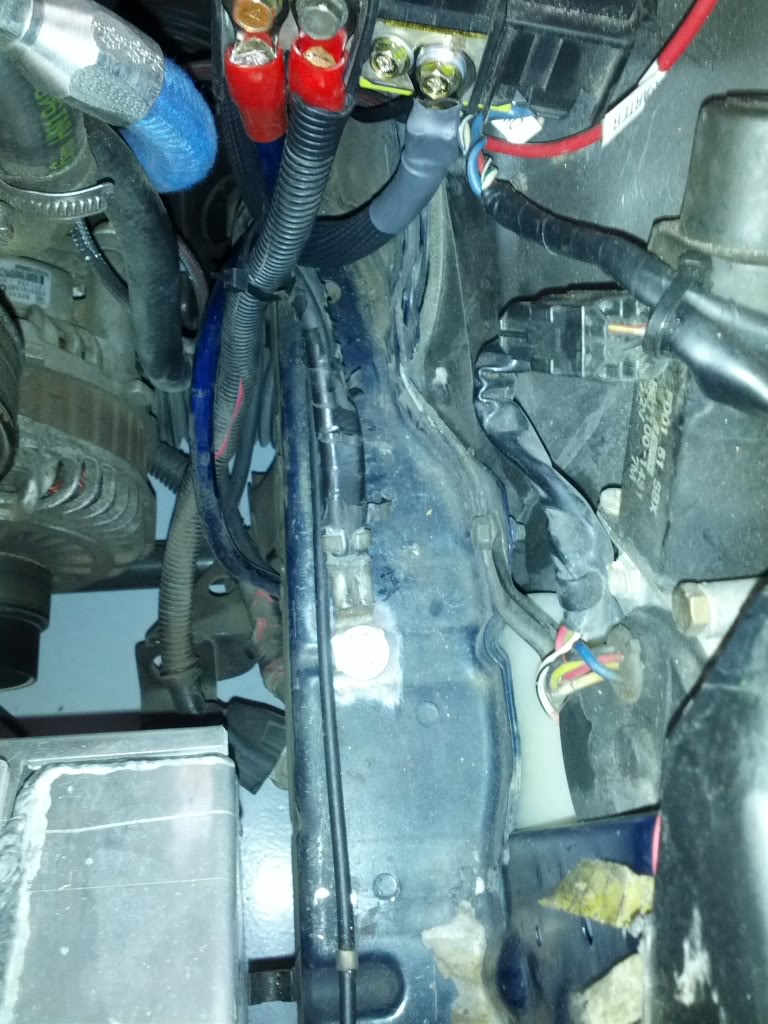
They both terminate directly under the bay on this post then split into two "red" wires.
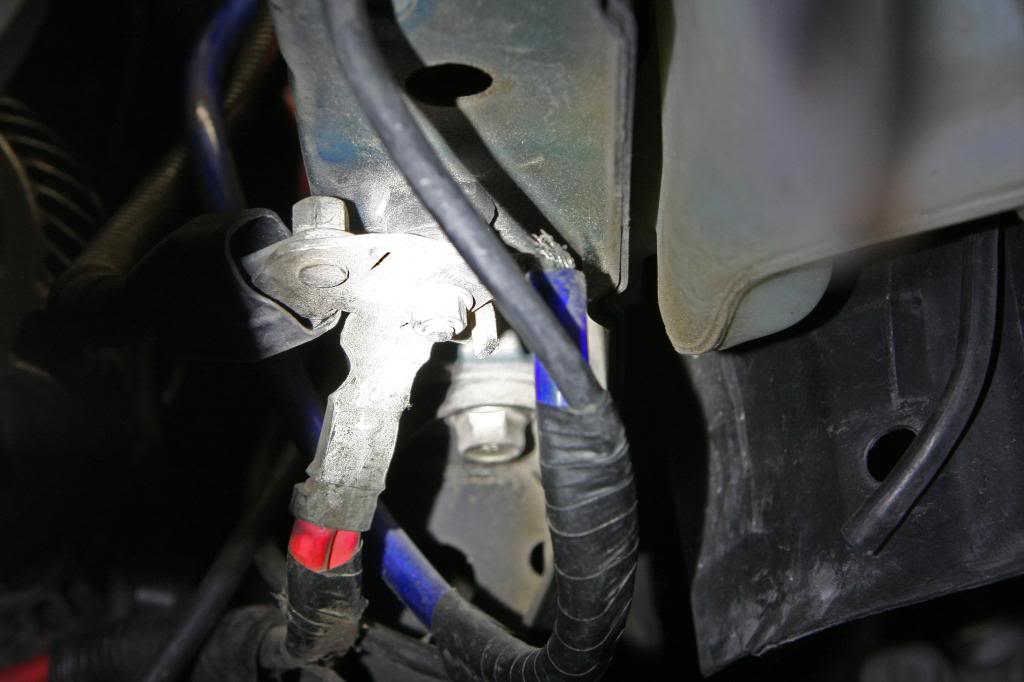
Then it looks like the two red wires run from that post to the starter.
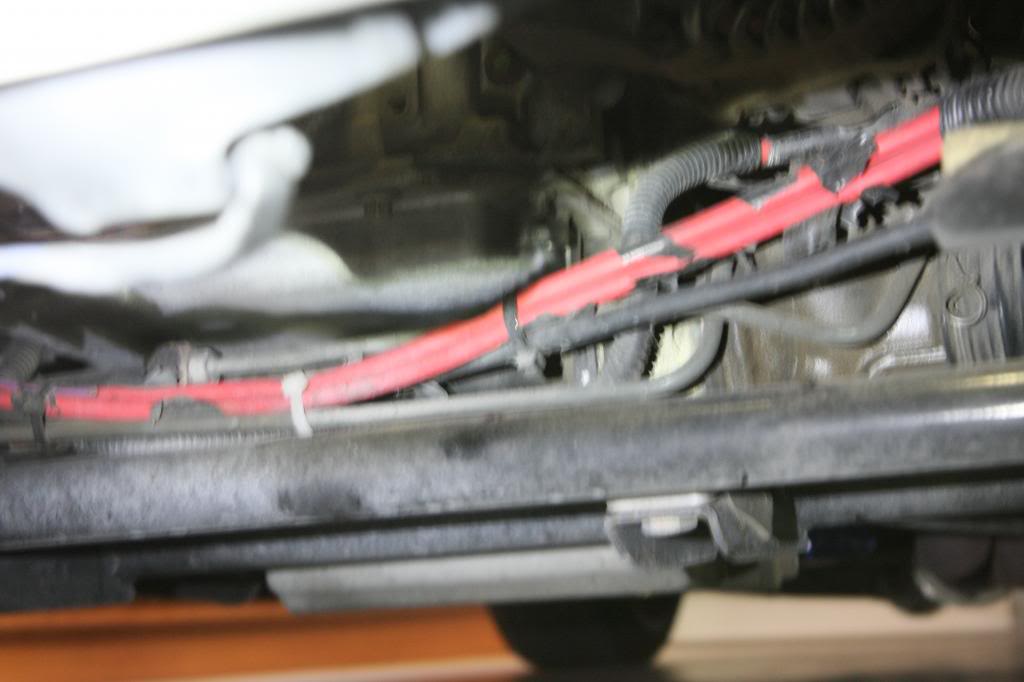
You can see one with a plastic loom. That looks like it runs from the starter to the alternator.
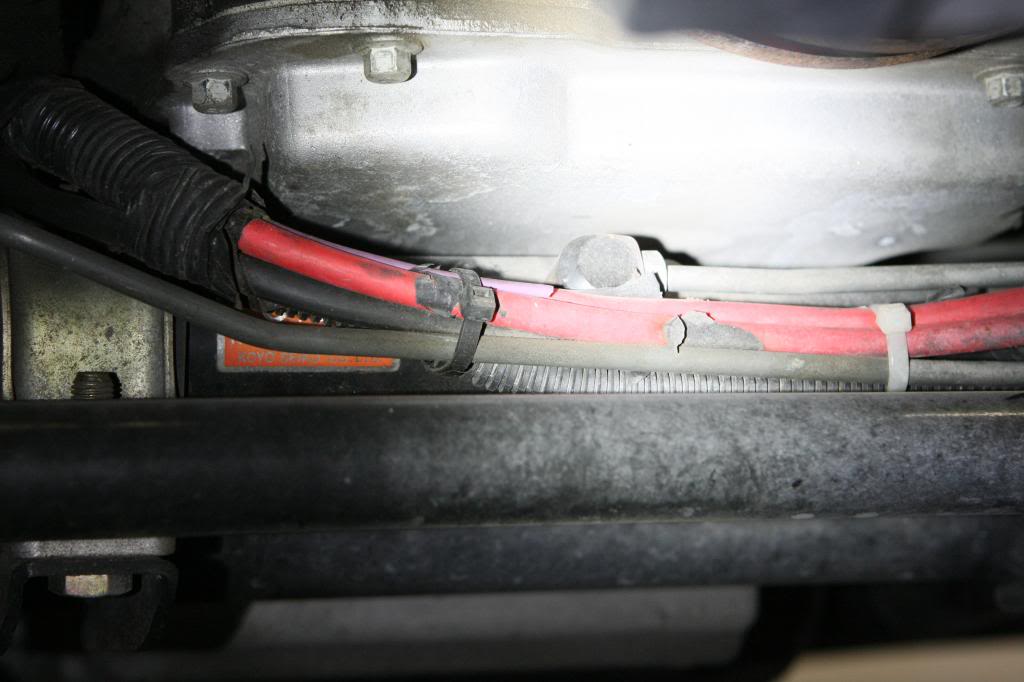
The ground looks like it literally runs from the strap on the driver engine bay, under the bay to the chassis, then over to the starter area. Then one more looks like it may ground the alternator.
My question is why are there 2 wires running from that junction to the starter? Isn't there a way to clean that up? Just looks "shoddy" to me. I would like to redo all that while I am at it.
This is what I found. There is a blue wire and the one with the plastic loom both coming out of the fuse block.

They run down directly under the engine bay

They both terminate directly under the bay on this post then split into two "red" wires.

Then it looks like the two red wires run from that post to the starter.

You can see one with a plastic loom. That looks like it runs from the starter to the alternator.

The ground looks like it literally runs from the strap on the driver engine bay, under the bay to the chassis, then over to the starter area. Then one more looks like it may ground the alternator.
My question is why are there 2 wires running from that junction to the starter? Isn't there a way to clean that up? Just looks "shoddy" to me. I would like to redo all that while I am at it.



